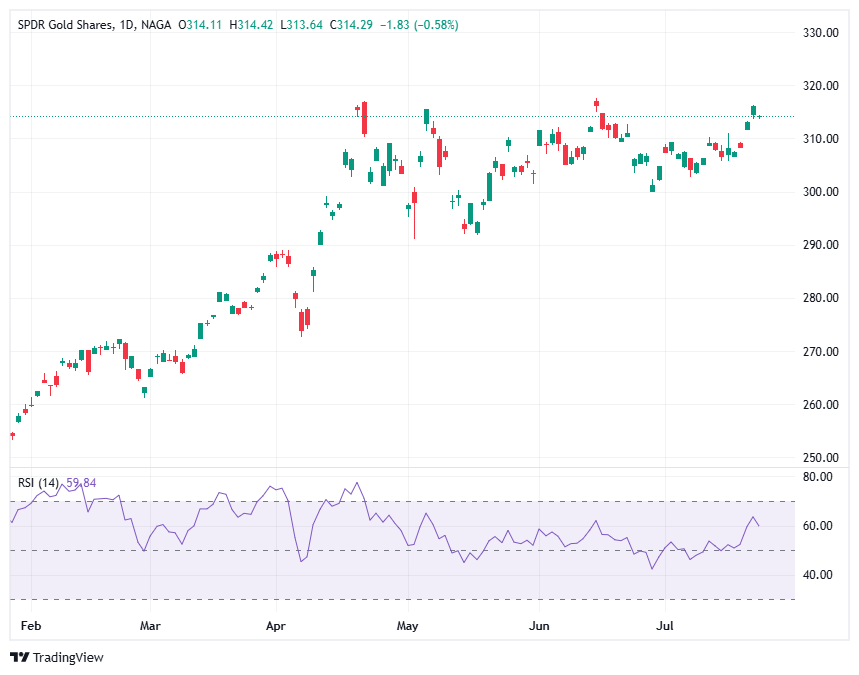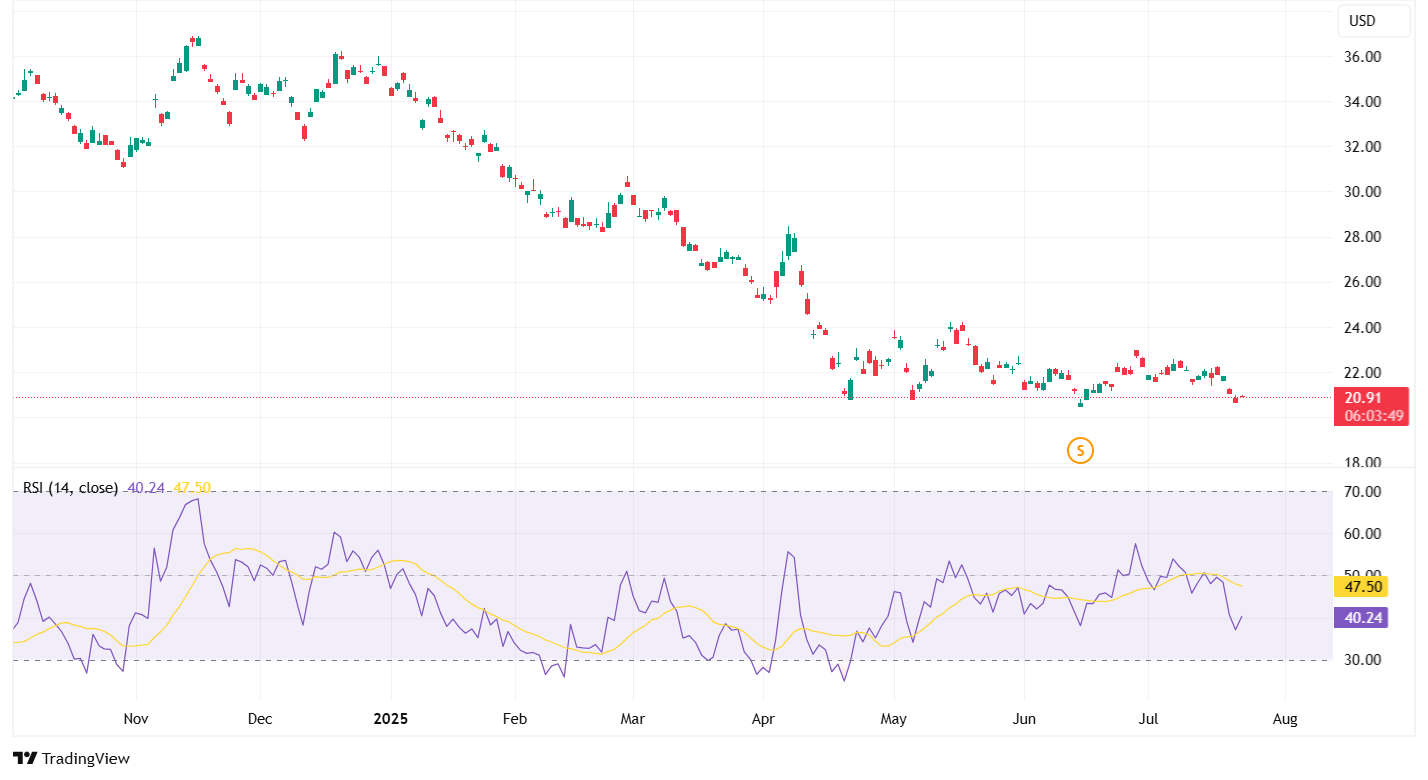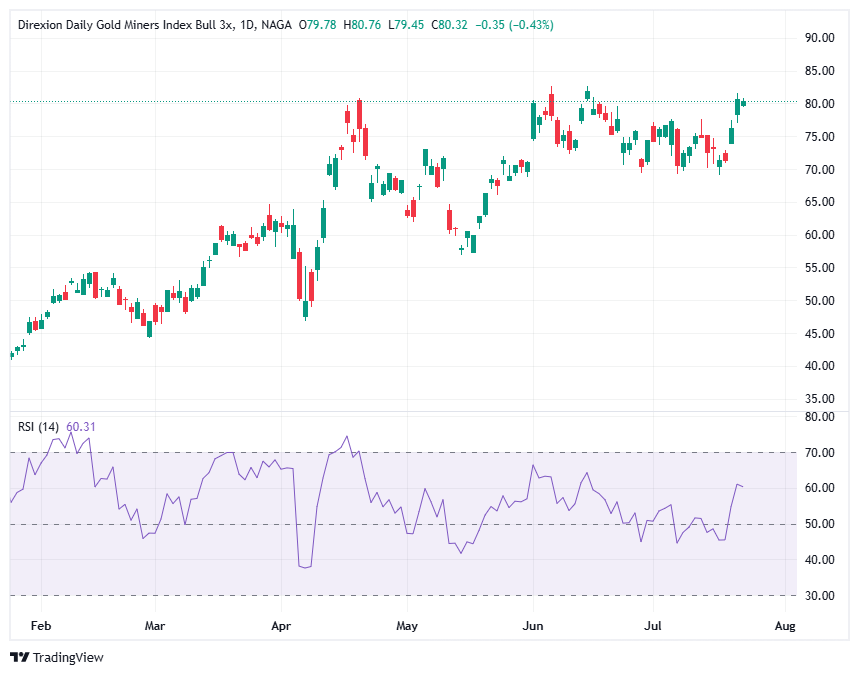There are multiple ways to gain exposure to gold, from directly purchasing gold bullion to more indirect methods like owning shares of public mining companies. To get in on the action, one of the most popular approaches for retail investors is through exchange-traded funds (ETFs) with gold as their underlying asset.
While some funds invest directly in the physical metal, others manage a portfolio of gold-related stocks. There is quite a bit you should know before you dive in. If you want to invest in Gold ETFs the right way, here is a quick guide that can help.
Getting Started with Gold ETFs - Quick Guide
- Research your Gold ETFs – Investors interested in hedging against inflation generally opt for Gold ETFs that hold gold bullion or futures, whereas investors who are particularly bullish on gold tend to also incorporate gold mining companies.
- Define your strategy – trading lets you speculate on the price movement; dealing lets you take direct ownership of the funds.
- Take your position – create an account with us to buy and trade in Gold ETFs.
What is a Gold ETF?
Gold ETFs are exchange-traded funds that give investors exposure to gold without having to directly purchase, store, and resell the precious metal. Some gold ETFs directly track the price of gold, while others invest in companies in the gold-mining industry.
As with other types of ETFs, the issuing company buys stock in gold-related companies or purchases and stores gold bullion itself. Investors buy shares in the fund, whose value rises and falls with the underlying gold price or company stock value.
Gold is considered a safe haven investment, as its price often rises as stock markets tumble.
Gold forecast and price prediction
Types of Gold ETFs
The main types of gold ETFs are categorized by the underlying assets or strategies they use:
1. Gold ETFs (exchange-traded opened gold trust)
A gold exchange-traded fund (ETF) is a fund that consists of just one asset: gold. Some are backed by physical gold, some have exposure to gold futures. Investors use gold ETFs to track and reflect the price of gold. While the assets in the fund are backed by the commodity, the intent is not for an investor to own gold.
A gold ETF gives an investor an opportunity to gain exposure to the performance, or price movements, of gold. In basic terms, buying gold ETFs means purchasing gold in electronic format. ETFs trade on a stock exchange just like a normal stock or equity but derive their value from holding ‘underlying assets’ that are centered on the precious metal.
What are ETFs and how do they work
2. Gold Miner ETFs
Another way to gain indirect exposure to gold is by investing in Gold Miner ETFs. Many investors see ETFs as a liquid and low-cost option for gaining exposure to this part of the gold industry.
Like gold stocks, Gold Mining ETFs are not a “pure play” on gold but rather invest in a broad basket of gold mining companies. These are ETFs that track gold mining stocks, rather than ETFs tracking gold as a commodity. The gold mining industry, as measured by the NYSE Arca Gold Miners Index, has significantly underperformed in the broader market.
Some of the best gold stocks for december 2025
3. Leveraged Gold ETFs
Designed to amplify daily returns of gold prices (e.g., 2x or 3x). These ETFs use derivatives to magnify gains or losses. They are suited for short-term trading rather than long-term holding due to volatility decay.
4. Inverse Gold ETFs
These use derivatives to provide inverse exposure, profiting when gold prices fall. Useful for hedging or speculating on declining gold prices.
5. Currency-Hedged Gold ETFs
These ETFs hedge against currency fluctuations (e.g., USD/EUR) to protect investors from exchange rate risks, often available in European markets.
6. Smart Beta or Thematic Gold ETFs
Some funds use quantitative strategies or focus on environmentally/socially responsible gold mining companies, offering thematic exposure beyond mere gold prices.
Summary Table
Type
Description
Key Features
Physical Gold ETFs/ETCs
Backed by actual gold bullion
Tracks gold spot price closely, low counterparty risk
Gold Mining ETFs
Invest in gold miners' stocks
Indirect exposure, company and gold price risks
Leveraged Gold ETFs
Use derivatives to amplify gold price returns
Higher risk, short-term trading focus
Inverse Gold ETFs
Provide inverse returns to gold price changes
Hedge against price drops
Currency-Hedged ETFs
Protect from currency exchange rate fluctuations
Useful for non-USD investors
Smart Beta/Thematic ETFs
Use factor strategies or ESG-focused mining stocks
Table with types of ETFs and their key features
Overall, physical gold ETFs/ETCs are the most popular for investors seeking direct gold price exposure with relatively low expense ratios, while other types cater to strategies involving leverage, hedging, or mining sector exposure.
Why invest in Gold ETFs?
Investing in Gold ETFs is popular because they provide a convenient, cost-effective, and liquid way to gain exposure to gold without the hassles of buying and storing physical metal. Gold ETFs track the price of gold closely and offer several advantages:
- Convenience and Liquidity: Gold ETFs can be bought or sold easily on stock exchanges during market hours, providing liquidity that physical gold cannot offer.
- Cost-Effectiveness: They eliminate costs and risks associated with physical gold storage and security since the underlying gold is held safely by the fund. Expense ratios are generally low, often including insurance, storage, and management fees.
- Portfolio Diversification: Gold tends to have a low correlation with stocks and bonds, so investing in Gold ETFs can reduce overall portfolio risk and provide a hedge against inflation and economic uncertainty.
- Safe Haven and Inflation Hedge: Gold historically serves as a hedge during financial crises, geopolitical uncertainty, inflationary periods, and even deflation, making it attractive for wealth preservation.
- Accessibility: Investors can start with small amounts, and investing through a trading or demat account is straightforward, requiring less knowledge than handling physical gold.
- Transparency: Prices of Gold ETFs are transparent and easy to track since they are publicly listed securities.
In summary, Gold ETFs combine the benefits of physical gold exposure with the flexibility, cost savings, and ease of use of equity investment vehicles, making them an efficient way to add gold to an investment portfolio. However, investors should be aware that Gold ETFs involve market risks similar to other securities.
Top 5 Gold ETFs
The following represent some of the more well-known gold ETFs. We have included funds that invest directly in either gold bullion or gold futures contracts as opposed to companies that mine for the metal.
- SPDR Gold Trust (GLD)
- 2× Short Leverage: ProShares UltraShort Gold (GLL)
- Direxion Daily Gold Miners Index Bull 3X
- Aberdeen Standard Gold ETF Trust (SGOL)
- VanEck Vectors Junior Gold Miners ETF
You can explore many types of gold ETFs, but before you include them in your investment strategy consider watching the performance of a few of the more popular funds. See how they move and if it works for your portfolio needs. Once you have a better understanding of gold ETFs, you'll likely find it easier to get started investing in them.
SPDR Gold Trust (GLD)
SPDR Gold Shares is the largest physically backed gold exchange-traded fund (ETF) in the world, with over $100 billion worth of AUM and the biggest gold ETF available to trade with NAGA.com.
GLD tracks the price of gold by holding gold bullion in a trust kept in the form of London Gold Delivery bars of 400 ounces, held in an allocated account. The physical gold is held by the custodian in a vault in London or in the vaults of other sub-custodians.

Past performance is not indicative of future results
The fund has an annual tracking error of around 0.93%. The tracking error is the difference between the price of the ETF and the underlying spot price of gold. It is caused mainly by the expenses charged for managing the fund, transaction costs, and whether the fund holds any cash. It's difficult to avoid a tracking error as this is a common aspect of operating a fund that any fund tracking a benchmark is likely to incur.
Trade SPDR Gold Trust CFD I Invest in SPDR Gold Trust
2× Short Leverage: ProShares UltraShort Gold (GLL)
UGL is structured as a commodity pool, combining investor contributions to trade futures-based leveraged long positions in gold. The fund offers bullish investors daily investment returns (before fees and expenses), corresponding to 2× the daily performance of the Bloomberg Gold Subindex.

Past performance is not indicative of future results
Investors should be advised that this ETF resets on a daily basis, so any investments in it should be monitored daily. Significant losses are possible, especially in volatile markets.
Direxion Daily Gold Miners Index Bull 3X
The Direxion Daily Gold Miners Index Bull 3X Shares (NUGT) is a leveraged ETF that seeks returns for short-term trades of a single day and is best suited for active, experienced investors who understand leverage risk and volatility.

Past performance is not indicative of future results
The fund attempts to achieve daily investment results of 300% of the performance of the NYSE Arca Gold Miners Index. The fund invests in high-risk futures contracts, reverse purchase agreements, options, and short positions.
Trade Direxion Daily Gold Miners CFD I Invest in Direxion Daily Gold Miners
Aberdeen Standard Gold ETF Trust (SGOL)
The Aberdeen Standard Physical Gold Shares ETF Trust is designed to track the price of physical gold bullion. Shares are backed by physical gold held in a trust in Switzerland. SGOL, which was launched on Sept. 9, 2009, has an expense ratio of 0.17% and total net assets of nearly $2.05 billion.
VanEck Vectors Junior Gold Miners ETF
The VanEck Vectors Junior Gold Miners ETF tracks gold mining stocks but is different because its benchmark, the MVIS Global Junior Gold Miners Index, is comprised of micro and small-cap gold and silver miners. Junior gold miners are either smaller stocks that produce gold or even those not yet in production and either explore gold or develop a project.
These types of stocks are exposed to different risks than large producers, such as project delays or poor exploration results, meaning their share prices are driven by different variables. The ETF has generated a return of 39.4% in the last 12 months.
How to Invest in Gold ETFs
There are two routes to investing in gold ETFs: speculating on their prices using CFDs or buying the shares of funds in the hope they increase in value.
Trading gold ETFs using CFDs
A CFD is a contract in which you agree to exchange the difference in the price of an asset from when you first open your position to when you close it. You are speculating on the price of the market rather than taking ownership of the stocks. If you open a long position and the stock or ETF does increase in value, you’ll make a profit, but if it falls in price, you’ll make a loss – the opposite is true for a short position.
Buying gold ETFs
This means that you take ownership of a portion of the fund outright, with the intention of holding it with a brokerage and profiting if it increases in value.
Get Started with NAGA.com
Here is how to trade and invest in gold ETFs with an international, highly regulated broker like NAGA.com:
- Choose which type of account you want to use. Your first concern should be your risk appetite and time horizon. If you want to buy and hold gold ETFs, open an investing account. If you want to speculate on price movements (including falling prices) with tight spreads and leverage, open a CFD trading account.
- Create an account. Regardless of your chosen account, you need to register and complete the KYC process to verify your identity.
- Fund your account with fiat money. Before buying and trading any gold stock, you need to fund your exchange account with U.S. dollars, Euros, or other currencies.
- Select your stocks. When selecting commodity ETFs, pay attention to factors like the fund’s performance, expense ratios, top holdings, and assets under management.
- Place a buy order for your chosen stock. Follow the steps required by the trading platform to submit and complete a buy order.
When trading stocks, the CFDs (contracts for difference) are stored in your account and are more liquid than the underlying asset. However, you should be aware that CFD trading is fast-moving and requires close monitoring. As a result, traders should be aware of the significant risks when trading CFDs. There are liquidity risks and margins you need to maintain; if you cannot cover reductions in values, your provider may close your position, and you'll have to meet the loss no matter what subsequently happens to the underlying asset.
With NAGA, you can trade a wide range of CFDs on stocks and invest in +3.000 stocks and ETFs with ownership.
Are gold ETFs right for you?
The most common reason people and companies invest in gold through ETFs is diversification. Owning various investments can theoretically minimize the risk of having too much exposure to a single asset.
Historically, gold has had a low correlation to the stock market. For example, during the financial crisis in 2008, gold prices rose 2 percent while the USA500, US Tech 100, or USA30 plunged around 40 percent.
Apart from diversification, gold also serves as a currency hedge for which demand rises when there are concerns about inflation diluting the purchasing power of fiat currencies (particularly those most widely held, like the USD and EUR).
Additionally, in times of political or social turmoil, investors often flock to gold as a safe haven, leaving behind more volatile assets. Gold has a strong track record as a highly effective portfolio diversifier and a defensive store of value. While gold has retained its value over the years, the commodity has been susceptible to erratic moves in the short term.
Some investors also argue that, unlike stocks, valuations for gold can be tricky to estimate. There are no earnings or cash flow metrics to analyze. Similarly, gold is a non-yielding asset, a turn-off for those looking for passive income like dividends.
2024 marked a significant reversal and resurgence for gold ETFs that attracted a net inflow of $3.4 billion globally, breaking a streak of three years of net outflows. This turnaround was fueled by heightened geopolitical tensions, hopes for interest rates cuts, and a strong rally in gold prices reaching historic highs multiple times.
Free resources
Before you start investing and trading in gold stocks, you should consider using the educational resources we offer like NAGA Academy or a demo trading account. NAGA Academy has lots of free trading courses for you to choose from, and they all tackle a different financial concept or process – like the basics of analyses – to help you become a better trader or make more informed investment decisions.
Our demo account is a suitable place for you to learn more about leveraged trading, and you’ll be able to get an intimate understanding of how CFDs work – as well as what it’s like to trade with leverage – before risking real capital. For this reason, a demo account with us is a great tool for investors who are looking to make a transition to leveraged trading.
Sources:
https://www.justetf.com/en/how-to/gold-etfs.html
https://www.blackrock.com/au/solutions/ishares/gold-etf

